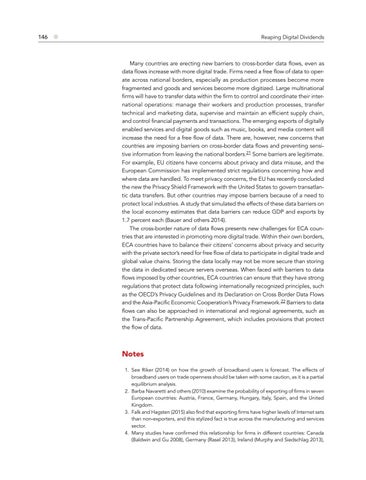146 ●
Reaping Digital Dividends
Many countries are erecting new barriers to cross-border data flows, even as data flows increase with more digital trade. Firms need a free flow of data to operate across national borders, especially as production processes become more fragmented and goods and services become more digitized. Large multinational firms will have to transfer data within the firm to control and coordinate their international operations: manage their workers and production processes, transfer technical and marketing data, supervise and maintain an efficient supply chain, and control financial payments and transactions. The emerging exports of digitally enabled services and digital goods such as music, books, and media content will increase the need for a free flow of data. There are, however, new concerns that countries are imposing barriers on cross-border data flows and preventing sensitive information from leaving the national borders.21 Some barriers are legitimate. For example, EU citizens have concerns about privacy and data misuse, and the European Commission has implemented strict regulations concerning how and where data are handled. To meet privacy concerns, the EU has recently concluded the new the Privacy Shield Framework with the United States to govern transatlantic data transfers. But other countries may impose barriers because of a need to protect local industries. A study that simulated the effects of these data barriers on the local economy estimates that data barriers can reduce GDP and exports by 1.7 percent each (Bauer and others 2014). The cross-border nature of data flows presents new challenges for ECA countries that are interested in promoting more digital trade. Within their own borders, ECA countries have to balance their citizens’ concerns about privacy and security with the private sector’s need for free flow of data to participate in digital trade and global value chains. Storing the data locally may not be more secure than storing the data in dedicated secure servers overseas. When faced with barriers to data flows imposed by other countries, ECA countries can ensure that they have strong regulations that protect data following internationally recognized principles, such as the OECD’s Privacy Guidelines and its Declaration on Cross Border Data Flows and the Asia-Pacific Economic Cooperation’s Privacy Framework.22 Barriers to data flows can also be approached in international and regional agreements, such as the Trans-Pacific Partnership Agreement, which includes provisions that protect the flow of data.
Notes 1. See Riker (2014) on how the growth of broadband users is forecast. The effects of broadband users on trade openness should be taken with some caution, as it is a partial equilibrium analysis. 2. Barba Navaretti and others (2010) examine the probability of exporting of firms in seven European countries: Austria, France, Germany, Hungary, Italy, Spain, and the United Kingdom. 3. Falk and Hagsten (2015) also find that exporting firms have higher levels of Internet sets than non-exporters, and this stylized fact is true across the manufacturing and services sector. 4. Many studies have confirmed this relationship for firms in different countries: Canada (Baldwin and Gu 2008), Germany (Rasel 2013), Ireland (Murphy and Siedschlag 2013),
